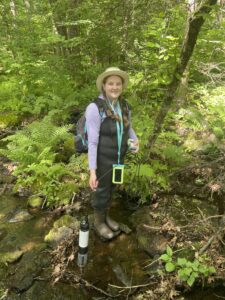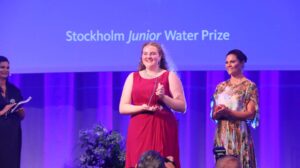Bridging the Gaps Between Science, Law, and Policy - Interview with Annabelle Rayson

Share with us a bit about who Annabelle Rayson is.
Annabelle Rayson is an Environmental Sciences and Engineering undergraduate student at Harvard University passionate about scientifically solving environmental challenges and bridging the gaps between science, law, and government policy. She was a research fellow at the Harvard Forest studying freshwater streams and winter forest methane emissions and has been awarded the Stockholm Junior Water Prize and other international accolades for her independent research on treating and preventing harmful algae blooms. She has served on several boards for environmental, education, and government policy. On campus, she researches heavy metal contamination in drinking water. After graduation, she hopes to use her learnings and talents to work towards ensuring accessible, safe, clean water for everyone.
What’s your favorite water memory?
Growing up around the Great Lakes, my life revolved around water, so it is rather difficult to pick a favourite water memory. But, if I must choose, my grandparents’ house was right on the lake, and I would love going to visit them in the summers and having backyard beach days with my family and friends.

You won the Stockholm Junior Water Prize. What was the inspiration for your project and what was it like to win the prize?
My project focused on using a specific species of freshwater zooplankton as a natural solution to treat and prevent harmful algae and cyanobacterial blooms in freshwater ecosystems. It was inspired by the impacts that harmful algae and cyanobacterial blooms have on the Great Lakes communities that I live in and especially the challenges they pose to my dad who is a commercial fisherman. Most of the current methods to treat harmful algae and cyanobacterial blooms have significant drawbacks and negatively impact water quality and aquatic life, so I wanted to find a better solution.
While in Stockholm for the event I was sure I wasn’t the winner. Before the winner was announced, a member of the judging panel briefly described the winning project and even mentioned algae blooms; however, I was fully convinced that it could not be me as there were so many wonderful projects. But then my project, name, and country were called; I was so shocked and excited that I ran into the audience to hug my mom.
Why did you want to intern with Xylem and the Reservoir Center?
I wanted to intern with Xylem and the Reservoir Center because I want to learn more about the water sector outside of research and gain exposure to all the different types of projects, work, and initiatives being designed and used. I am especially excited to learn more about policy initiatives, the Reservoir Center partner organizations and explore community outreach and education.

When you aren’t thinking about water how do you like to spend your free time?
I am an avid curler and during the curling season, I spend as much free time as I have out on the ice! I have been curling since I was four years old, and I have been a member of my university’s curling program since my first year and currently serve as its President and Team Captain. Outside of the curling season, I love to bake and kayak. I have also been the Chair of the Sarnia Shoebox Project since 2018 working to support women impacted by homelessness and domestic abuse.
What’s one water challenge you hope is solved in your lifetime?
I firmly believe that everyone should have access to clean, safe, reliable water, so I hope that challenge is solved in the course of my lifetime, and it is a challenge that I would like to work to help solve across the globe.
